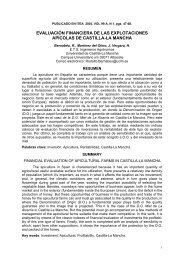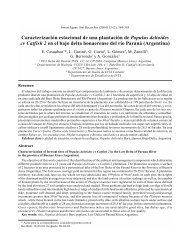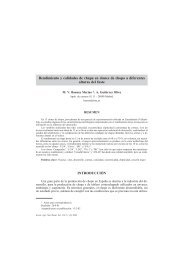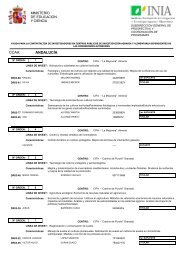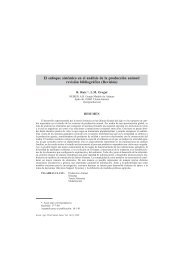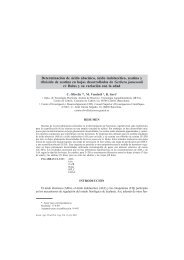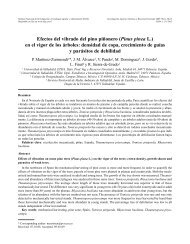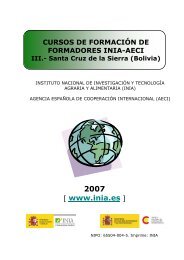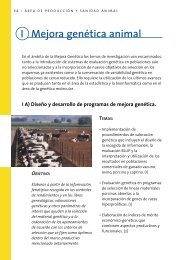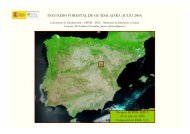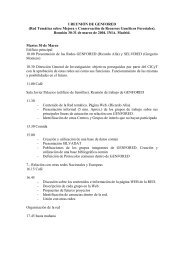Status of medicinal and aromatic plants in - Inia
Status of medicinal and aromatic plants in - Inia
Status of medicinal and aromatic plants in - Inia
You also want an ePaper? Increase the reach of your titles
YUMPU automatically turns print PDFs into web optimized ePapers that Google loves.
28<br />
WORKING GROUP ON MEDICINAL AND AROMATIC PLANTS: FIRST MEETING<br />
• Collect<strong>in</strong>g <strong>plants</strong> for their diversity<br />
MAP collect<strong>in</strong>g is funded by IPGR, through national <strong>and</strong> <strong>in</strong>ternational projects.<br />
MAP collect<strong>in</strong>g <strong>in</strong> Sadovo started as early as 1902, but significant activities related to<br />
genetic resources started <strong>in</strong> 1983 with the establishment <strong>of</strong> <strong>in</strong>ternational exchanges with<br />
botanical gardens, research <strong>in</strong>stitutes, firms, etc. (Guteva et al. 1998).<br />
Active collaboration <strong>and</strong> germplasm exchange are currently ma<strong>in</strong>ta<strong>in</strong>ed with the Research<br />
Institute for Roses, Aromatic <strong>and</strong> Medic<strong>in</strong>al Plants <strong>in</strong> Kazanlak, the Agricultural University<br />
<strong>in</strong> Plovdiv, the Institute <strong>of</strong> Botany <strong>in</strong> S<strong>of</strong>ia, as well as with non-governmental organizations<br />
(NGOs).<br />
The collection <strong>of</strong> wild accessions started <strong>in</strong> 1993 <strong>and</strong> is carried out through collect<strong>in</strong>g<br />
missions <strong>in</strong> different regions <strong>of</strong> the country. A total <strong>of</strong> four jo<strong>in</strong>t projects with the Committee<br />
<strong>of</strong> Forests, the M<strong>in</strong>istry <strong>of</strong> Education <strong>and</strong> Science, the Bulgarian/Swiss Biodiversity<br />
Conservation Programme (BSBCP) <strong>and</strong> 13 collect<strong>in</strong>g missions <strong>in</strong> the country were carried out<br />
dur<strong>in</strong>g the period reported.<br />
• Creation <strong>and</strong> structure <strong>of</strong> the collections<br />
The strategy for the creation <strong>of</strong> collections is to achieve:<br />
- Species diversity<br />
- Intraspecific diversity<br />
- Diversity <strong>of</strong> <strong>plants</strong> with protected status<br />
- Ecogeographic diversity.<br />
The ex situ MAP collection <strong>in</strong> IPGR is represented by 461 accessions distributed <strong>in</strong> 24<br />
families. The highest species diversity is found <strong>in</strong> the families Lamiaceae (28 species) <strong>and</strong><br />
Asteraceae (15). Other families <strong>in</strong>clude from 1 to 7 species (Table 1).<br />
Table 1. Structure <strong>of</strong> the ex situ field collection<br />
No.<br />
Family<br />
No. <strong>of</strong> accessions<br />
No. <strong>of</strong><br />
species Total Wild Foreign<br />
Bulgarian<br />
(local cultivars <strong>and</strong><br />
populations)<br />
1 Amaryllidaceae 1 23 - 23 -<br />
2 Araceae 1 1 1 - -<br />
3 Asteraceae 15 292 18 252 22<br />
4 Borag<strong>in</strong>aceae 1 3 3 - -<br />
5 Caryophyllaceae 7 9 5 4 -<br />
6 Cistaceae 2 2 2 - -<br />
7 Crassulaceae 3 3 3 - -<br />
8 Fabaceae 3 3 3 - -<br />
9 Ericaceae 2 2 2 - -<br />
10 Gentianaceae 1 1 1 - -<br />
11 Hypericaceae 1 2 2 - -<br />
12 Iridaceae 6 12 10 2 -<br />
13 Lamiaceae 28 83 69 5 10<br />
14 Malvaceae 1 1 1 - -<br />
15 Onagraceae 2 2 2 - -<br />
16 Paeoniaceae 2 3 3 - -<br />
17 Primulaceae 2 2 2 - -<br />
18 Ranunculaceae 4 4 4 - -<br />
19 Resedaceae 1 1 1 - -<br />
20 Rosaceae 4 4 4 - -<br />
21 Rubiaceae 1 1 1 - -<br />
22 Rutaceae 1 1 1 - -<br />
23 Scrophulariaceae 5 5 5 - -<br />
24 Solanaceae 1 1 1 - -<br />
Total 95 461 143 286 32




